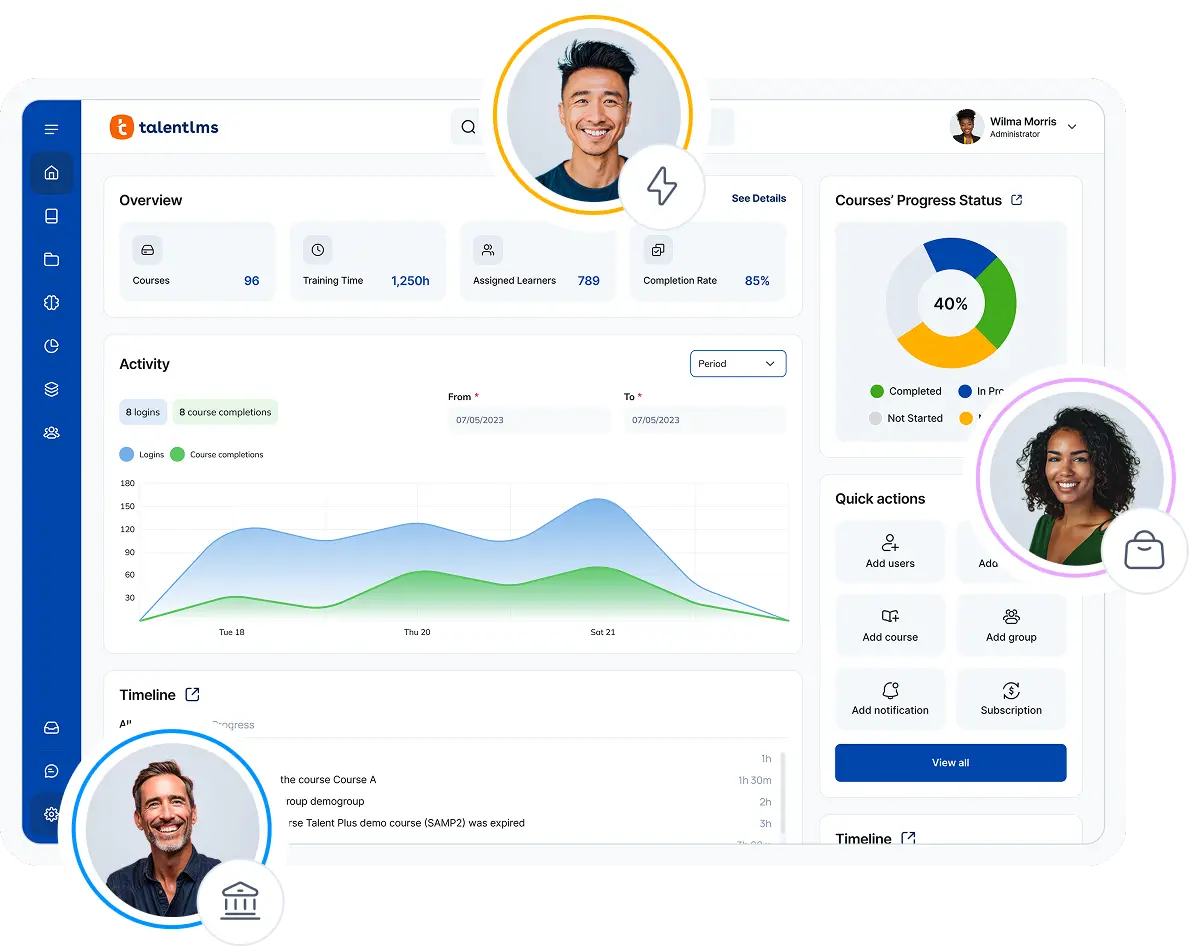We all know a company’s greatest asset is its people.
But let’s be honest, annual performance reviews and the occasional training session just don’t cut it anymore.
To truly thrive in an ever-changing landscape, you need a workforce that’s constantly learning, adapting, and growing. In other words, you need to adopt a learning culture.
Ready to ditch the outdated approach and invest in a business strategy that fuels success?
Read on to learn the top 8 strategies to transform your organization into a learning force to be reckoned with.
What is a learning culture in the workplace?
Before we define what a learning culture is, let’s first go over what it’s not.
For starters, a learning culture is more than just a few training sessions scattered throughout the year.
Plus, the focus shouldn’t be on isolated pockets of excellence within the company, where some are eager to learn and grow, while others just go through the motions. Nor is it simply a matter of top management telling employees to learn.
It’s about weaving learning into the very fabric of your organization.
Think of it as an environment where you encourage employees to grow. A place where knowledge sharing is the norm, and where everyone feels comfortable taking risks and learning from their mistakes.
In a true learning culture, employees are given the tools and resources they need to explore skills-based learning, pursue their passions, and reach their full potential. This not only benefits them but also fuels innovation and drives the entire organization forward.
Benefits of creating a learning culture in the workplace

Why bother with all this effort to build a learning culture?
Because the payoff is huge. Andy Lancaster, a pioneer leader in people development, discusses the concept of a learning culture in our Keep it Simple episode, “Supercharging your workplace learning culture“.
Boosts innovation and creativity
The numbers speak the truth. Deloitte found that companies with a strong learning culture are a whopping 92% more likely to innovate and 58% more likely to be prepared for future market trends. That’s a serious competitive edge you don’t want to miss out on.
Increases employee satisfaction and retention
When employees are constantly learning and growing, they become more engaged, productive, and innovative. They’re also more likely to be satisfied with their jobs and stay with the company longer. In fact, a 2024 study by TalentLMS says that 41% of employees will look for another job if their company doesn’t provide them with training opportunities.
Therefore, investing in ongoing learning and career development helps boost employee retention.
Encourages knowledge sharing
Knowledge sharing is essential for keeping important information accessible and easy to find across an organization. When employees openly share what they know, everyone benefits—whether they’re tackling a problem now or planning ahead.
Lancaster says, “Organizations are using socialized environments to gather, acquire, share, access, and use information. So it’s a really important way of managing knowledge within the organization.” This makes knowledge management an active, practical part of work rather than just storing information.
Set individual learning goals
Encouraging self-directed learning empowers employees to take charge of their growth. Actively participating in designing and engaging with their training helps them become less dependent on formal learning. As Andy Lancaster puts it, “That’s changing [learners’] thinking and also empowering them not to be dependent on us.” This approach builds a more resilient, agile learners who continuously grow within supportive communities.
But the benefits don’t stop there. A learning culture can also lead to:
- Increased productivity and efficiency
- Boosted customer satisfaction
- Enhanced adaptability in an ever-changing market
8 ways to create a learning culture in your organization
Creating a learning culture requires a multifaceted approach that takes into account employee needs. The following strategies can guide your learning organization on this transformative journey.
1. Cultivate a growth mindset
Ever heard the saying “you can’t teach an old dog new tricks”?
Well, that old cliché couldn’t be more off-target.
Regardless of how old you are, the human brain is an incredible ‘machine’ that is constantly adapting and evolving.
A growth mindset is all about embracing that potential and believing that you can always learn and improve, no matter where you’re starting from.
Research by Stanford psychologist Carol Dweck has shown that people with this mindset are more likely to embrace challenges, persist in the face of setbacks, and achieve higher levels of performance.
Leaders must champion this mindset by acknowledging their own learning journeys, encouraging risk-taking, and celebrating both successes and failures as opportunities for growth.
2. Promote learning in the flow of work
The best learning happens when it’s integrated into the everyday workflow.
Your team is already collaborating, problem-solving, and tackling new challenges every day. Why not make that a learning opportunity?
According to Lancaster, “[…] if we’re looking at learning in the flow of work, which essentially communities often is, it’s grabbing time in the moment or is connecting with people when it’s relevant.”
Here are some ways to do that:
- Help create communities of interest (communities that gather together around a theme in an informal way) where people can connect and learn from each other.
- Build a culture where asking questions and seeking developmental feedback is encouraged.
- Extend lunch hours to allow for informal problem-solving and relationship-building opportunities.
3. Offer mentorship opportunities
Mentoring is a powerful way to accelerate learning, build strong relationships, and create a sense of community.
Pair up experienced employees with those who are just starting out, and watch the sparks fly. Mentees get valuable guidance and support, while mentors get to share their expertise and develop their leadership skills. It’s a win-win that benefits everyone across the board.
4. Create socialized learning communities
Lancaster goes on to discuss how social learning has become one of the most important ways of implementing a culture of learning. He says, “Over 91% of teams now rank learning together as really important, and it’s in the top drivers of great work culture.”
In a socialized and collaborative learning environment, employees can share their experiences, ask questions, and get feedback from their peers. It also helps build a sense of community within the organization, which can improve employee engagement and morale.
One way to create a socialized learning community is to use Andy Lancaster’s 7 Cs model:
This model identifies seven key elements that together create a recipe for success:
5. Encourage self-directed learning
As discussed, self-directed learning is a positive byproduct of a continuous learning culture. It’s also something that should be actively encouraged.
Self-directed learning empowers employees to take ownership of their development journey by being in control of what and when they learn.
To help cultivate this, provide employees with the autonomy to choose learning paths that align with their personal goals and interests. However, this doesn’t happen overnight. Lancaster discusses how social learning helps the transition from dependent learners to self-directed learners.
A simple way to do this is by using Learning Management Systems (LMSs) are invaluable tools for encouraging self-directed learning. They offer curated libraries of courses, learning paths, and the ability for employees to track their progress and identify areas for improvement.
6. Lead by example
To create a culture where people can learn on their own, you need more than just guidance and motivation. You also need strong leadership and a commitment to living the values you want to teach.
However, there’s often a disconnect between how senior leaders perceive themselves and how their employees view them.
TalentLMS Research on Growth Mindset in the Workplace 2024 report reveals that while 96% of executives believe they have a growth mindset, only 45% of employees agree. This gap shows that leaders and managers need to learn the skills and behaviors to truly show they are willing to grow.
As Lancaster states, “We’ve got to rewire the organization and I’ve never been able to do that without getting managers and leaders involved with that one. And you know how a really good way is to challenge managers and leaders to be in a socialized group themselves.”
7. Integrate learning platforms
Employee training software are great tools to help you build a learning culture in your workplace.
They incorporate elements such as discussion boards that facilitate the creation of organic communities. These types of communities aren’t created by leadership. They are “[…] very flexible, very informal, a really nice way of gathering for community. And often they have really high engagement because there is this strong buy-in because we pioneered something together,” says Lancaster.
Plus, these platforms encourage learner engagement through gamification. As Lancaster puts it, “[…] giving people credit and recognition for being great community members really matters, and I think within organizations that might be, yeah, digital badges are a great way of doing this, and I think those can be really relevant.”
So, these platforms are a great way to establish a learning culture throughout the organization.
8. Reward learning
Recognizing and rewarding learning achievements reinforces positive behaviors and shows that the organization is committed to employee development.
As mentioned, LMS gamification features like badges and points can be a fun and effective way to acknowledge learning milestones and encourage friendly competition.
But rewards don’t have to be limited to virtual trophies.
Consider giving tangible incentives like cash bonuses, extra days off, or opportunities for professional development.
These rewards not only show appreciation for employees’ efforts but also create a tangible link between learning and career advancement.
Bonus tip: Making learning a core value
Building a learning culture isn’t just about adapting to the future; it’s about shaping it. It’s about leaving a legacy that extends beyond profits and products, a legacy of growth, empowerment, and human connection.
Doing this shows that you are serious about your organization’s learning culture, which can motivate employees to jump on this core value and embody a growth mindset.
Executing this shift in mindset requires a commitment from the top down.
When you invest in a learning culture, you’re not just strengthening your business—you’re building a lasting legacy of growth, empowerment, and connection. This ripple effect reaches your employees, your customers, and your entire community.
Embrace the power of a learning culture, and watch your organization transform into a force for positive change.





